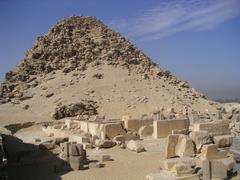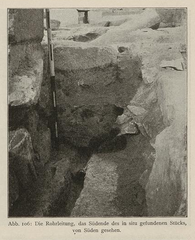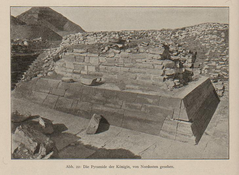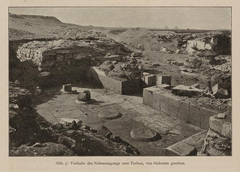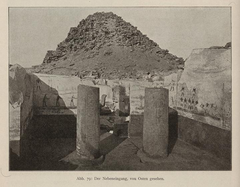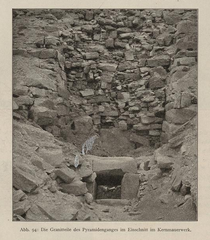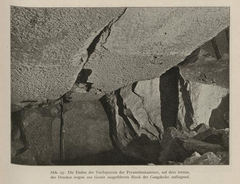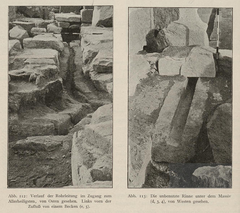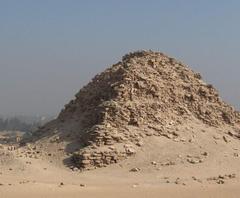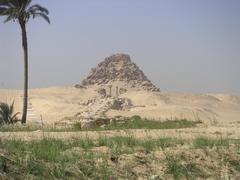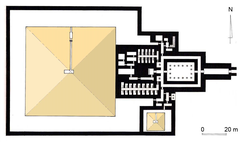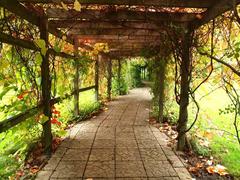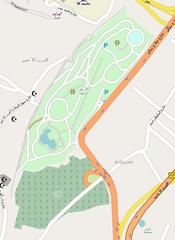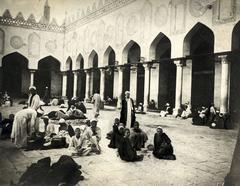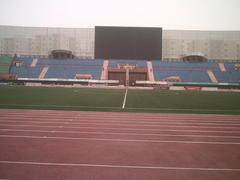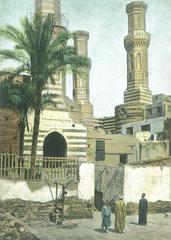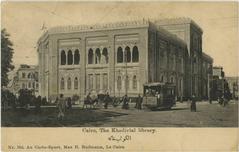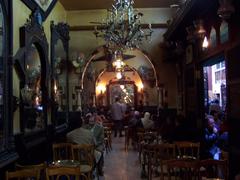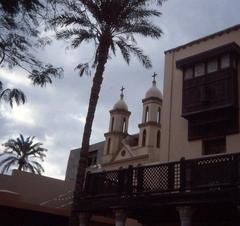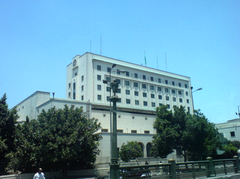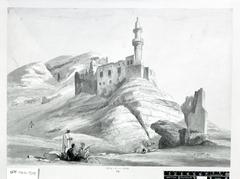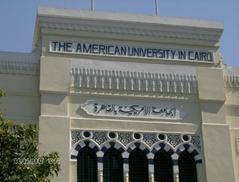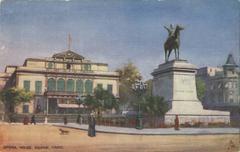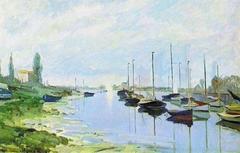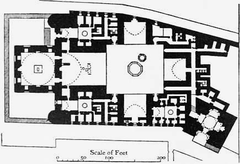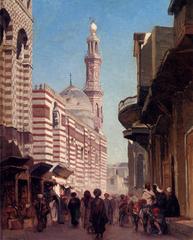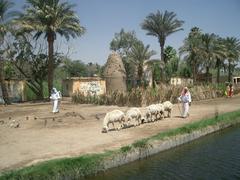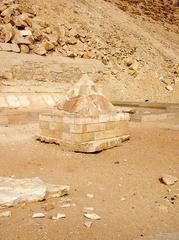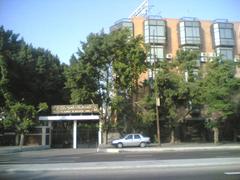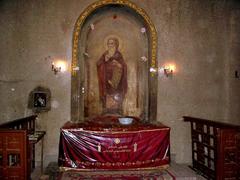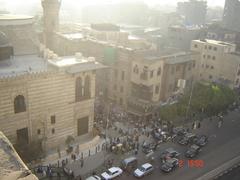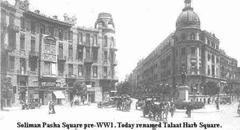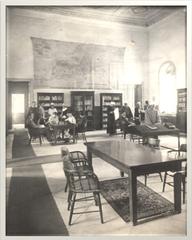
Visiting the Pyramid of Sahure: Hours, Tickets, and Tips
Date: 17/08/2024
Introduction
The Pyramid of Sahure, situated in the Abusir necropolis near Cairo, Egypt, is a fascinating monument that offers an unparalleled glimpse into the architectural and cultural achievements of Egypt’s Fifth Dynasty. Constructed around 2480 BC, the pyramid complex was commissioned by Pharaoh Sahure, the second ruler of the Fifth Dynasty. This site is renowned for its architectural innovations, intricate decorative reliefs, and significant historical discoveries. Visitors to the Pyramid of Sahure can explore its rich history, marvel at its construction techniques, and gain insights into the religious and cultural practices of ancient Egypt (Wikipedia, Ancient Egypt Tours). The complex not only includes the pyramid itself but also a valley temple, a causeway, and a mortuary temple, all of which highlight the sophistication and artistry of the period (Egypt Tours Portal). Recent archaeological efforts have uncovered hidden chambers and have utilized advanced technologies like 3D laser scanning to enhance our understanding of this ancient structure (Archaeology Mag). This guide will provide you with comprehensive information on the historical background, ticket prices, visiting hours, and travel tips to make your visit to the Pyramid of Sahure an unforgettable experience.
Table of Contents
- [Introduction](#introductionintroduction)
- [Historical Background](#historical-backgroundhistorical-background)
- [Construction and Architectural Innovations](#construction-and-architectural-innovationsconstruction-and-architectural-innovations)
- [Excavations and Discoveries](#excavations-and-discoveriesexcavations-and-discoveries)
- [Decorative Reliefs and Artistic Significance](#decorative-reliefs-and-artistic-significancedecorative-reliefs-and-artistic-significance)
- [Religious and Cultural Significance](#religious-and-cultural-significancereligious-and-cultural-significance)
- [Structural Details and Preservation](#structural-details-and-preservationstructural-details-and-preservation)
- [Recent Discoveries and Technological Advancements](#recent-discoveries-and-technological-advancementsrecent-discoveries-and-technological-advancements)
- [Visitor Information](#visitor-informationvisitor-information)
- [Visiting Hours](#visiting-hoursvisiting-hours)
- [Ticket Prices](#ticket-pricesticket-prices)
- [Accessibility](#accessibilityaccessibility)
- [Nearby Attractions](#nearby-attractionsnearby-attractions)
- [Sahure’s Legacy](#sahures-legacysahures-legacy)
- [FAQ](#faqfaq)
- [Conclusion](#conclusionconclusion)
Historical Background
Construction and Architectural Innovations
The Pyramid of Sahure, constructed around 2480 BC, marks a significant development in ancient Egyptian architecture. As the first pyramid built in Abusir, it set a precedent for subsequent Fifth Dynasty pyramids (Wikipedia). The pyramid complex was commissioned by Pharaoh Sahure, the second ruler of the Fifth Dynasty, and was constructed using limestone blocks transported from the Tura quarry. The exterior was originally covered in smooth white limestone, which has since been removed by stone robbers (Ancient Egypt Tours).
The pyramid’s architectural design featured several innovations, including the use of palmiform columns and a unique layout for the mortuary temple. These elements became benchmarks in ancient Egyptian construction (Egypt Tours Portal). The pyramid complex also included a valley temple, a causeway, and a mortuary temple, all integral parts of the complex that showcased the sophistication and artistry of the time (Travel2Egypt).
Excavations and Discoveries
The site was first thoroughly excavated by Ludwig Borchardt between March 1907 and 1908. Borchardt’s work culminated in the publication of “Das Grabdenkmal des Königs Sahu-Re” (The Funerary Monument of King Sahure) between 1910 and 1913, which remains a standard reference for the pyramid complex (Wikipedia). More recently, a joint Egyptian-German archaeological mission led by Dr. Mohamed Ismail Khaled made significant discoveries within the pyramid, including previously undocumented storage rooms. This project utilized cutting-edge technology like 3D laser scanning to enhance the understanding of Sahure’s pyramid (Archaeology Mag).
Decorative Reliefs and Artistic Significance
The Pyramid of Sahure is renowned for its intricate decorative reliefs, which covered approximately 10,000 square meters of walls, though only 150 square meters have survived. These reliefs include a remarkable hunting scene spanning 8 meters by 3 meters, considered unparalleled in ancient Egyptian art (Egypt Tours Portal). The mortuary temple alone featured 370 meters of relief, compared to the 100 meters found in Khufu’s Great Pyramid (Egypt Tours Portal).
The reliefs depict various scenes, including an expedition to Punt, a military campaign against the Libyans, and Sahure fishing and hunting. These scenes symbolize the pharaoh’s sacred duty to show mastery over nature and also highlight Sahure’s foreign relations, as evidenced by the depiction of bears probably imported from Syria (Ancient Origins).
Religious and Cultural Significance
Sahure’s pyramid complex played a crucial role in the religious and cultural landscape of ancient Egypt. The mortuary temple became a focal point for the worship of the goddess Sekhmet, who was venerated from the Eighteenth Dynasty through the Ptolemaic Kingdom (Egypt Tours Portal). Sahure also established a funerary cult that endured beyond his reign, sustained by agricultural estates. Although the cult’s significance dwindled in the Middle Kingdom, it saw a resurgence during the New Kingdom, attracting devotees from across Egypt (Egypt Tours Portal).
Structural Details and Preservation
The main pyramid stood around 78.5 to 78.75 meters long and between 47 and 48 meters tall. It was constructed from limestone blocks and encased in fine white Tura limestone. The core of the pyramid was composed of six steps of limestone held together with mud mortar, with an entrance to the north encased in fine white limestone (Egypt Tours Portal). The internal chambers were plundered, hindering accurate reconstruction, but fragments of a basalt sarcophagus were found, indicating the king’s burial (Egypt Tours Portal).
The pyramid’s preservation has been a challenge. Ancient times peeled away the casing stones, leaving the pyramid open to the elements. Throughout the Medieval Ages, the pyramid was used as a quarry for construction materials. European archaeologists dug up the site in the 19th century (Your Egypt Tours).
Recent Discoveries and Technological Advancements
In recent years, the conservation and restoration project initiated in 2019 aimed to protect the substructure of Sahure’s pyramid. The project utilized advanced technology, such as 3D laser scanning with a ZEB Horizon portable LiDAR scanner, to facilitate detailed surveys of both the extensive external areas and the narrow corridors and chambers inside the pyramid (Archaeology Mag). This technology provided real-time scanning updates and a permanent record of the exploration, enhancing the understanding of Sahure’s pyramid and challenging existing paradigms in pyramid construction.
The discovery of the storerooms represents a significant milestone in understanding the architectural innovations of King Sahure, who may have been a pioneer in this field. The restoration work focused on cleaning interior rooms, stabilizing the pyramid, and preventing further collapse, making the burial chambers accessible (Archaeology Mag).
Visitor Information
Visiting Hours
The Pyramid of Sahure is open to visitors daily from 8:00 AM to 5:00 PM. It is advisable to visit early in the morning to avoid crowds and the midday heat.
Ticket Prices
Tickets are available at the entrance. The standard ticket price for adults is approximately $10, with discounts available for students and children.
Accessibility
While the site is partially accessible, some areas may be challenging for visitors with mobility issues due to uneven terrain and narrow passageways. It is advisable to wear comfortable shoes and bring water, especially during the hotter months.
Nearby Attractions
The Pyramid of Sahure is part of the Abusir necropolis, which includes several other notable pyramids and tombs. Nearby attractions include the Pyramids of Neferirkare, Niuserre, and the Sun Temple of Userkaf.
Sahure’s Legacy
Pharaoh Sahure’s reign was marked by peace and prosperity, with trade and foreign relations flourishing. His pyramid complex is a testament to his architectural and artistic contributions, which have left a lasting legacy in ancient Egyptian history (Ancient Origins). Despite the pyramid’s current state of preservation, it continues to offer valuable insights into the religious beliefs, daily life, and artistic achievements of the Old Kingdom (Ancient Egypt Tours).
FAQ
Q: What are the visiting hours for the Pyramid of Sahure?
A: The Pyramid of Sahure is open daily from 8:00 AM to 5:00 PM.
Q: How much are tickets to the Pyramid of Sahure?
A: The standard ticket price for adults is approximately $10, with discounts available for students and children.
Q: Are there guided tours available?
A: Yes, guided tours are available and can provide additional insights into the historical and architectural significance of the pyramid.
Q: What should I wear when visiting?
A: It is advisable to wear comfortable shoes and bring water, especially during the hotter months.
Q: Are there other attractions nearby?
A: Yes, the Pyramid of Sahure is part of the Abusir necropolis, which includes several other notable pyramids and tombs.
Conclusion
The Pyramid of Sahure is a fascinating destination for anyone interested in ancient Egyptian history and architecture. By visiting, you not only get to witness the grandeur of a bygone era but also contribute to the preservation of this incredible site. Don’t miss out on the opportunity to explore this historic monument and learn more about the rich cultural heritage of Egypt.
References
- Wikipedia, 2023, Multiple Authors Wikipedia
- Ancient Egypt Tours, 2023, Multiple Authors Ancient Egypt Tours
- Egypt Tours Portal, 2023, Multiple Authors Egypt Tours Portal
- Travel2Egypt, 2023, Multiple Authors Travel2Egypt
- Archaeology Mag, 2023, Multiple Authors Archaeology Mag
- Ancient Origins, 2023, Multiple Authors Ancient Origins
- Your Egypt Tours, 2023, Multiple Authors Your Egypt Tours
